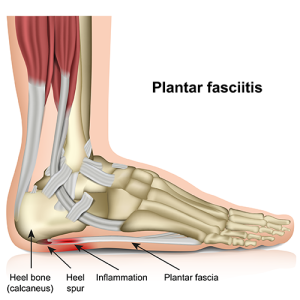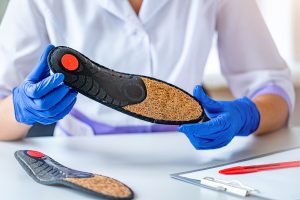You should call a podiatrist any time you experience pain, discomfort or noticeable changes in your feet. Podiatrists are the foot and ankle experts, treating cases including bunions, Cavus foot, heel slides, shin splints, broken bones, reconstruction, surgical procedures and more. From the tibial tuberosity down to the tip of your toes, LECOM Health podiatrists do any and all surgeries and treat all foot and ankle injuries.
Jason E. Lee, D.P.M., a board-certified podiatrist at LECOM Health Millcreek Surgical Specialists and Eastside Medical Center, shares information about the biggest culprits of foot and ankle injuries, and ways to prevent injuries from ever happening.
Most common foot and ankle injuries
The most common types of foot and ankle injuries depend on the generation, age and lifestyle of the patient.
- Ankle sprains are very common. We see many of these cases coming into the emergency room and our office.
- Many athletes experience ankle sprains.
- Sometimes people just step off a curb or walk down stairs and sprain their ankle.
- Plantar fasciitis is another type of injury we treat very often. It affects people of all ages.
- Many professionals wear dress shoes or flats, which really don’t have good arch support.
- Women’s shoes, specifically, are notorious for not being stable and not having good arch support.
- We see it most commonly in winter when people are wearing boots. Boots are known for being flat without arch support.
- In the summer, people like to go barefoot or wear flip-flops. Flip-flops are a terrible shoe and traditionally have been very flat. They aren’t supportive at all. Beyond wearing them to the beach, they shouldn’t be worn.
When you’re having pain, you have to change behaviors to get rid of the pain.
What is plantar fasciitis?
 Plantar fasciitis is inflammation of the plantar fascia. The most painful area is usually at the insertion into the heel. Anyone who is on his or her feet a lot will encounter some heel pain at some point. Luckily, it’s something we can treat almost always without surgery, using very successful, conservative treatments. Usually with good shoe gear, a supportive arch, and a good stretching routine, we can get rid of 99.9% of the plantar fasciitis.
Plantar fasciitis is inflammation of the plantar fascia. The most painful area is usually at the insertion into the heel. Anyone who is on his or her feet a lot will encounter some heel pain at some point. Luckily, it’s something we can treat almost always without surgery, using very successful, conservative treatments. Usually with good shoe gear, a supportive arch, and a good stretching routine, we can get rid of 99.9% of the plantar fasciitis.
Quite often if it’s chronic or long lasting, you’ll get some spurring at that area. Bone doesn’t know what else to do when it’s hurt, crushed or pulled on except grow more bone. That’s why you see the spur. A lot of patients think it’s facing down toward the ground because it feels like you’re stepping on something sharp. But it actually grows along the plantar fascia. So the pain doesn’t directly correlate with the spur; it’s just a side effect of plantar fasciitis.
It can be debilitating. Some people can’t even walk around because they’re in so much pain.
Certainly high heels or flat shoes are not very supportive for the arch. That puts more stress and strain on the plantar muscles of the foot. When they get stretched and pulled on, the muscles don’t like that, so they cramp up and cause toe crossing, toe curling, pain in the arch, etc. Pain from plantar fascia does migrate into the arch.
But again, with the stretches that we give, a good regimen of consistent and daily all-throughout-the-day stretching, along with maybe some anti-inflammatories and good arch supports or good shoe gear, we’re very successful at getting rid of that.
Consistently wear supportive shoes and arches – even in the home
You may be wearing supportive shoes eight or 10 hours at work, but when you get home you’re removing them and walking around the house barefoot or in socks. Until you are completely better, you have to wear something for arch support, even in the home. This consistent routine is the hardest part. It begins the moment you wake up until the time you go to bed.
Especially in Erie, PA, where it’s muddy, snowy and rainy, we’re conditioned to take off our shoes as soon as we enter the house. I recommend keeping a second pair of proper shoes with inserts by the door to put on inside the house to wear until bedtime.
Think of it like Mister Rogers from ‘Mister Rogers’ Neighborhood.’ Sit down and take off your shoes and put on another pair of shoes with inserts when you get into the house.
It is really helpful. When you feel that pain, you’ll be willing to do that.
You have to be strict or you will never get rid of it completely. Once you get rid of the heel pain and you’re 100% cured, you can absolutely try walking around in a slipper or a sock or even barefoot in the house again.
Stretch your feet often
Not everyone is made the same; we all have different posterior muscle groups. We have to stretch them differently.
The general rule is to stretch your Achilles tendon a minimum of four times a day – three stretches of 15 seconds each, four times a day.
Once you’re out of pain, you probably won’t have to do it that often.
 Every doctor, exercise physiologist, physical therapist, exercise scientist … everyone knows that stretching things out every day is good for you. Yoga is a great way to do that. Continuing to stretch can keep you from trouble.
Every doctor, exercise physiologist, physical therapist, exercise scientist … everyone knows that stretching things out every day is good for you. Yoga is a great way to do that. Continuing to stretch can keep you from trouble.
I prefer using ice in a water bottle over a tennis ball for rolling. It still gives the stretching on the arch, but it also gives the ice component to relieve inflammation and pain.
Keep your Achilles stretched, and wear supportive shoe gear when you’re out and walking around a lot. Diabetics should wear supportive shoe gear and protection for the foot – do not go barefoot in the backyard.
Achilles is the largest, most powerful tendon in your body, so once it is injured or ruptured, it’s a very big deal and takes a long time to heal. So, an appropriate and accurate repair of it is very, very important.
Not that we want anyone to get injured and have to have surgery, but if they do, that is something we excel at and are well trained in. I enjoy doing it. Some of my favorite surgeries to do are ankle fractures, heel slides, bunions, mid-foot fractures – something called a Lisfranc fracture, and any type of Achilles work.
Three types of shoe inserts
- The gel pad is very soft and squishy. If you can squeeze it with your fingers, how is it going to hold up your entire body when you’re walking on them? Gel pad inserts are the cheapest you can get. They sound like they’re going to be nice, but they’re not addressing the problem of why you’re having pain. Save your $5 – $15; it’s a waste of your money, they are not going to work.
- The next option is an over-the-counter but more supportive insert. It’s usually about $30 – $40. These inserts are typically good for about 80% of the population with a normal arch. They’re made on conveyor belts, so they’re not going to be a good choice for people with higher arches or lower arches, but they work very well for the average foot. They’ll be worth your money: They’ll last about a year to a year and a half, depending on how much you use them. Thirty dollars for no pain for a year and a half is a pretty good deal.
- The custom-made inserts are the gold standard. They’ll fit exactly to your arch. The staff specialists at the store will take an imprint of your foot or have you step into foam and make a negative cast out of that, and then make an insert to that cast. They’ll be fitting your foot, no one else’s, and be a perfect fit for your foot. This works very well for people who have higher arches, something the over-the-counter options aren’t going to help. Or if you have a flatter foot, you can’t wear a high or normal arch support. It’s going to rub on your foot and cause blisters, redness and pain, and you’re just going to be in pain and throw them out. You should have them custom made for your foot.
How do you treat babies with foot and ankle injuries?
I’ve treated patients from one day old all the way up to 103 years old. Babies tend to correct a lot easier with bracing and casting. We try not to do surgical procedures on babies very much, although some conditions require surgery right away.
They do respond to casting a lot better. They have open growth plates. The saying that babies are made out of rubber is kind of true. They’re not completely formed; they don’t have hard bones until they’re 12 – 16 years old. So we have a lot more nonsurgical options to try to correct those deformities before they become a permanent thing.


